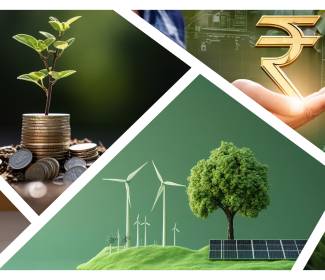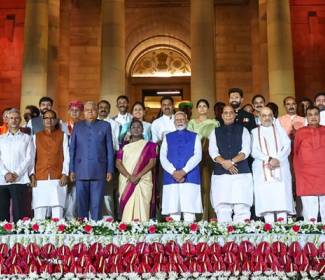Today, we stand at a crucial juncture in our global efforts to combat climate change. As India embarks on its journey to be the third-largest economy by 2030, it is imperative to decouple this progress towards a 7 Tn economy from harmful carbon emissions. India is the world’s third largest emitter of greenhouse gases (GHG) after China and the U.S but has low per-capita emissions (1.8 Tonnes CO2) as compared to the global average of 4.4 Tonnes CO2. Recognising a moral responsibility towards a greener planet, our Hon’ble Prime Minister took the Panchamrit Pledge with targets till 2030 and India being carbon-neutral by 2070. As highlighted during the COP 27, India balances its developmental needs with lower carbon emissions through Common but Differentiated Responsibilities and Respective Capabilities (CBDR-RC) principles. Mission LiFE and the recently launched Green Credit Program promote a sustainable lifestyle. However, building on the Electricity Conservation Act, 2001 and the Environment (Protection) Act, 1986 to launch a Carbon Credits Trading Scheme (CCTS), underlines India’s move to leverage climate finance and low-cost climate technologies for a just economic transition. The CCTS is a unified Indian Carbon Market (ICM) established to reduce GHG emissions through the trading of carbon credit certificates. Obligated entities will have GHG emission intensity targets and will receive or purchase carbon credit certificates based on their performance. India currently operates two market-based emission reduction schemes: the Perform, Achieve and Trade (PAT) scheme and the Renewable Energy Certificates (REC) system. Through the national carbon market, the Indian government will create an additional avenue for entities to trade carbon certificates apart from the voluntary market, wherein India is believed to be the second largest source of carbon offsets globally.
Over the past year, while the adoption of carbon pricing has been limited, there are promising signs of uptake in middle-income nations. Currently, there are 75 carbon taxes and emissions trading schemes in operation worldwide, reflecting a net gain of two carbon pricing instruments over the past 12 months. Middle-income countries such as Brazil, India, and Turkey have made significant progress towards implementing carbon pricing mechanisms. Carbon pricing instruments cover around 24% of global emissions. The potential introduction of new carbon taxes and emissions trading systems (ETSs) could increase this coverage to almost 30%.
The CCTS allows non-obligated entities to participate in the tradable carbon credits market enables registration of projects and obtaining tradable carbon credit certificates (CCCs), each representing one tonne of carbon dioxide equivalent (tCO2e). The compliance segment is scheduled to commence in 2025-26. India has identified the opportunity for deployment and will use the platform to attract investments and technology in emerging sectors. This is done by not simply promoting vanilla solar projects but through 13 sectors such as green hydrogen, sustainable aviation fuel, and off-shore wind. To ensure integrity in the monitoring, reporting and verification process and logically the certificates themselves, the National Steering Committee for Indian Carbon Market (NSCICM), and the Bureau of Energy Efficiency (BEE), as the administrator of CCTS, have the task of specifying the Baseline and Monitoring methodology for the specified activities. Since then, BEE has organised stakeholder consultation workshops to discuss the Accreditation of Carbon Verification Agencies and Detailed Procedures for Compliance Market under the Indian Carbon Market.
For the private players, the journey ahead has two-fold impacts. First, if and when a sector is included in compliance-based emission trading, the organisation can reduce emissions in line with government-set limits or simply purchase carbon credits. Second, carbon credits can represent an extra revenue stream for many companies. Indian enterprises stand at the threshold of a lucrative venture, tapping into the thriving global carbon trading markets.
The CCTS also represents a collaboration of multiple government stakeholders across ministries and regulators. The Bureau of Energy Efficiency (BEE) will administer the scheme and formulate targets, while the Central Electricity Regulatory Commission (CERC) will regulate trading. However, more details are needed for the scheme to take off effectively. Moving forward, the focus must be on ensuring the quality and credibility of carbon credits. Quality involves three key aspects: credibility, durability, and spillover benefits.
- Credibility: Reliable carbon credits verified by reputable agencies, with the necessary documentation, easily and transparently monitored.
- Durability: How permanent the carbon credit is.
- Spillover effects: Additional positive social or environmental benefits attributed to the carbon credit.
In conclusion, India's ambitious carbon market reforms and the global momentum towards carbon pricing are crucial steps in our journey towards a sustainable future. By addressing these challenges head-on and ensuring the integrity and quality of carbon credits, we can build a robust market that helps mitigate climate change while driving economic growth and innovation.
The report Carbon markets as a tool for climate financing: The India Story, jointly published by Invest India, Carbon Markets Association of India, National Institute of Public Finance & Policy, and auctusESG, delves deep into carbon markets and the policy landscape available globally, the challenges and their impact on India, and the way forward for India’s Carbon Market. Taking three focus sectors: energy, mobility, and agriculture, the report covers case studies, corporate-level actions, and interventions needed by financial institutions.
- https://www.mckinsey.com/~/media/mckinsey/business%20functions/sustainability/our%20insights/decarbonizing%20india%20charting%20a%20pathway%20for%20sustainable%20growth/Decarbonising-India-Charting-a-pathway-for-sustainable-growth-ES-Oct-2022.pdf
- https://pib.gov.in/PressReleasePage.aspx?PRID=1795071
- https://pib.gov.in/PressReleaseIframePage.aspx?PRID=1895858#:~:text=Minister%20of%20State%20for%20Environment,capabilities%20(CBDR%2DRC).
- https://www.cseindia.org/discredited-the-voluntary-carbon-market-in-india-11873
- https://carboncredits.com/carbon-pricing-revenues-hit-record-104b-in-2023-world-bank/#:~:text=Currently%2C%20there%20are%2075%20carbon,towards%20implementing%20carbon%20pricing%20mechanisms
- https://pib.gov.in/PressReleaseIframePage.aspx?PRID=1900216






